Attached files
| file | filename |
|---|---|
| 8-K - 8-K - FTI CONSULTING, INC | d482159d8k.htm |

FTI Consulting, Inc. Third Quarter 2017 Earnings Conference Call Exhibit 99.1
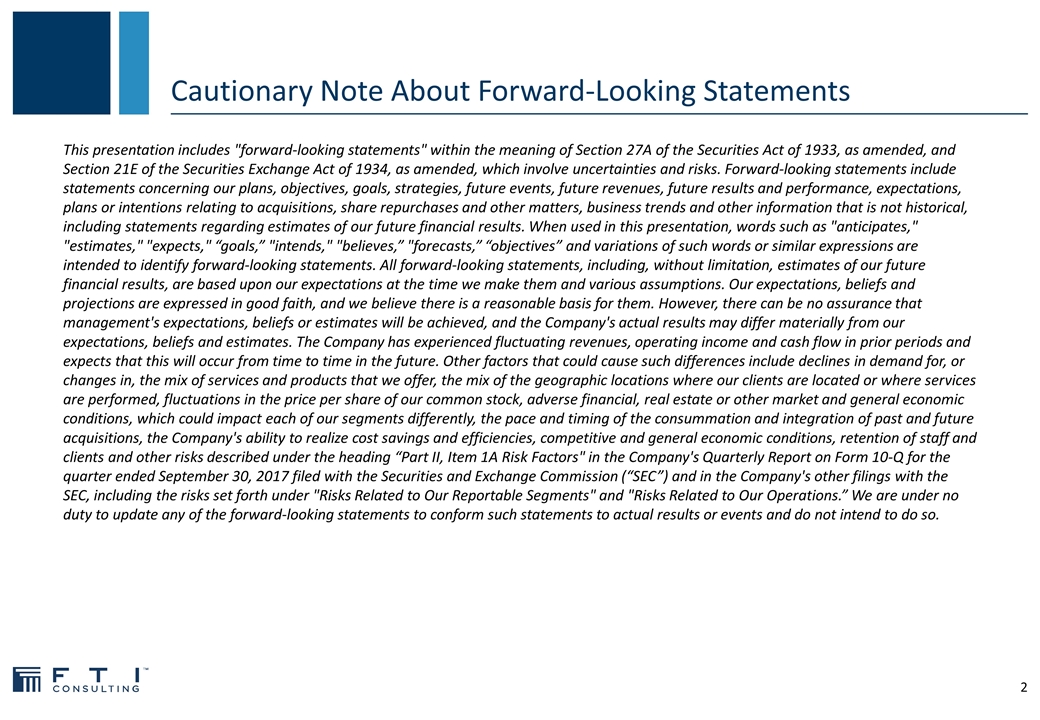
Cautionary Note About Forward-Looking Statements This presentation includes "forward-looking statements" within the meaning of Section 27A of the Securities Act of 1933, as amended, and Section 21E of the Securities Exchange Act of 1934, as amended, which involve uncertainties and risks. Forward-looking statements include statements concerning our plans, objectives, goals, strategies, future events, future revenues, future results and performance, expectations, plans or intentions relating to acquisitions, share repurchases and other matters, business trends and other information that is not historical, including statements regarding estimates of our future financial results. When used in this presentation, words such as "anticipates," "estimates," "expects," “goals,” "intends," "believes,” "forecasts,” “objectives” and variations of such words or similar expressions are intended to identify forward-looking statements. All forward-looking statements, including, without limitation, estimates of our future financial results, are based upon our expectations at the time we make them and various assumptions. Our expectations, beliefs and projections are expressed in good faith, and we believe there is a reasonable basis for them. However, there can be no assurance that management's expectations, beliefs or estimates will be achieved, and the Company's actual results may differ materially from our expectations, beliefs and estimates. The Company has experienced fluctuating revenues, operating income and cash flow in prior periods and expects that this will occur from time to time in the future. Other factors that could cause such differences include declines in demand for, or changes in, the mix of services and products that we offer, the mix of the geographic locations where our clients are located or where services are performed, fluctuations in the price per share of our common stock, adverse financial, real estate or other market and general economic conditions, which could impact each of our segments differently, the pace and timing of the consummation and integration of past and future acquisitions, the Company's ability to realize cost savings and efficiencies, competitive and general economic conditions, retention of staff and clients and other risks described under the heading “Part II, Item 1A Risk Factors" in the Company's Quarterly Report on Form 10-Q for the quarter ended September 30, 2017 filed with the Securities and Exchange Commission (“SEC”) and in the Company's other filings with the SEC, including the risks set forth under "Risks Related to Our Reportable Segments" and "Risks Related to Our Operations.” We are under no duty to update any of the forward-looking statements to conform such statements to actual results or events and do not intend to do so.
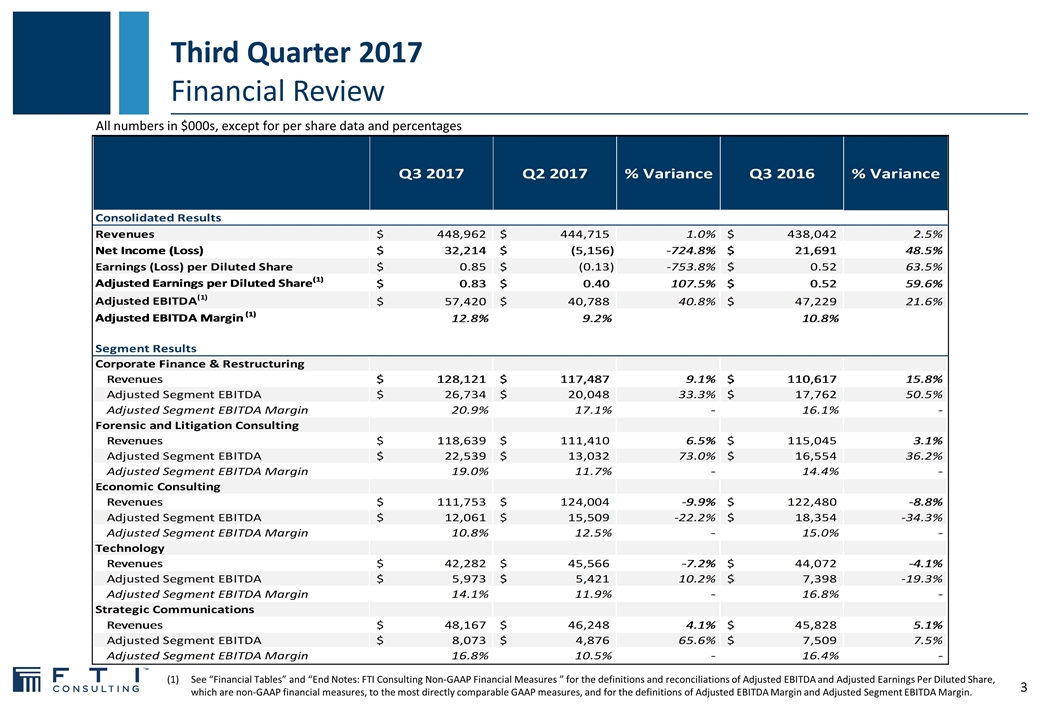
Third Quarter 2017 Financial Review All numbers in $000s, except for per share data and percentages See “Financial Tables” and “End Notes: FTI Consulting Non-GAAP Financial Measures ” for the definitions and reconciliations of Adjusted EBITDA and Adjusted Earnings Per Diluted Share, which are non-GAAP financial measures, to the most directly comparable GAAP measures, and for the definitions of Adjusted EBITDA Margin and Adjusted Segment EBITDA Margin.
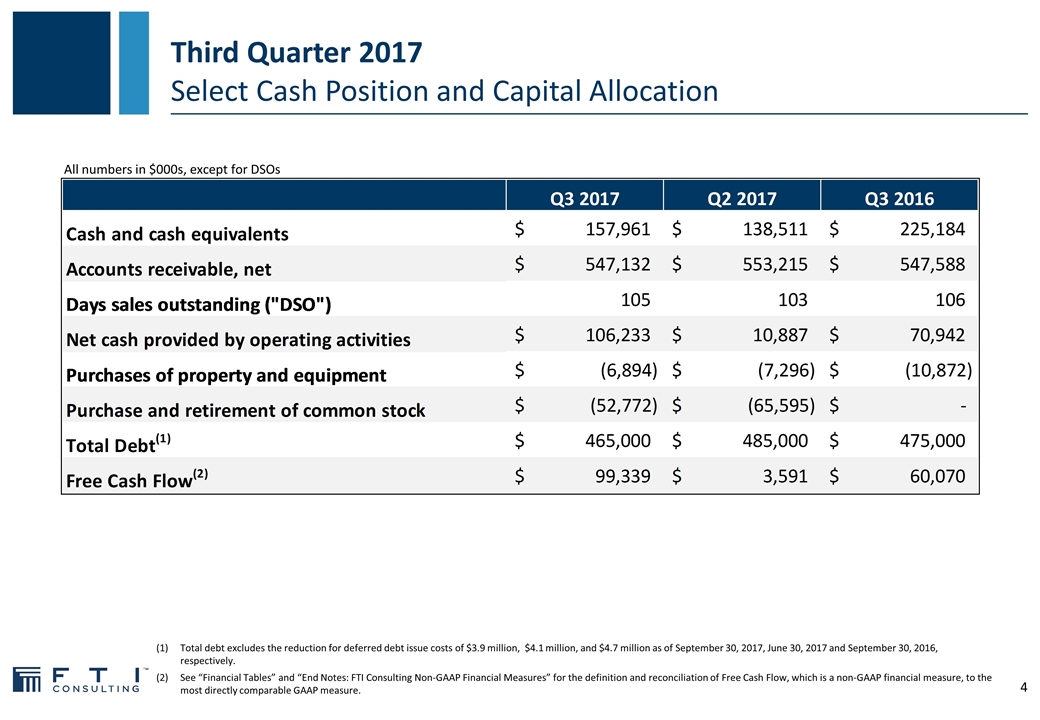
Third Quarter 2017 Select Cash Position and Capital Allocation Total debt excludes the reduction for deferred debt issue costs of $3.9 million, $4.1 million, and $4.7 million as of September 30, 2017, June 30, 2017 and September 30, 2016, respectively. See “Financial Tables” and “End Notes: FTI Consulting Non-GAAP Financial Measures” for the definition and reconciliation of Free Cash Flow, which is a non-GAAP financial measure, to the most directly comparable GAAP measure. All numbers in $000s, except for DSOs

Financial Tables
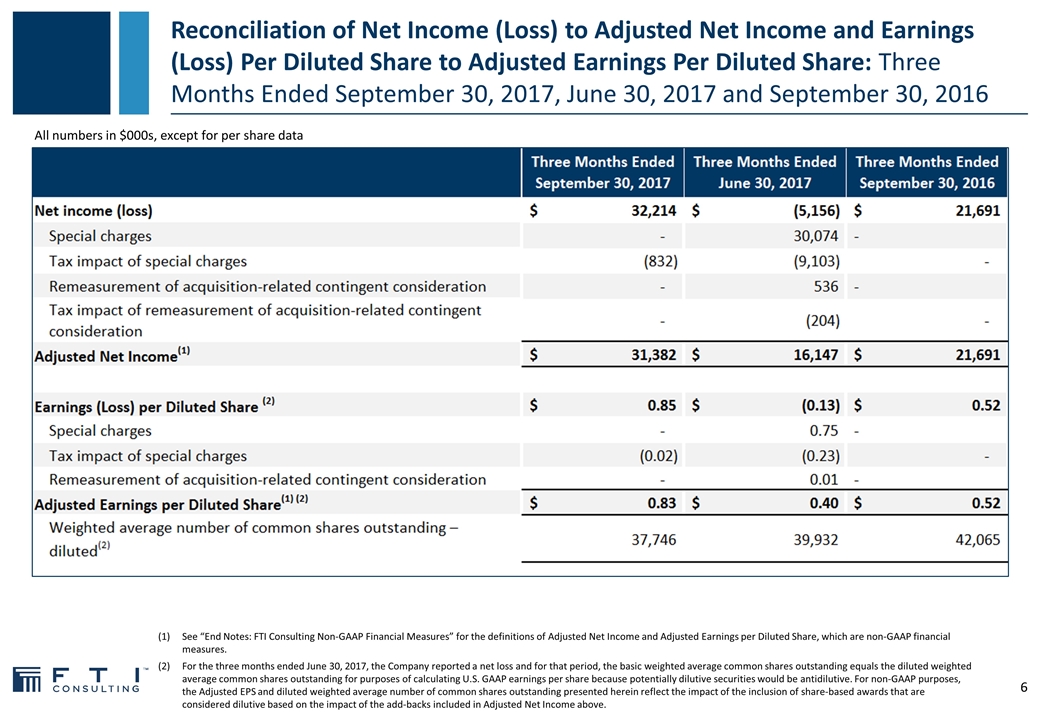
Reconciliation of Net Income (Loss) to Adjusted Net Income and Earnings (Loss) Per Diluted Share to Adjusted Earnings Per Diluted Share: Three Months Ended September 30, 2017, June 30, 2017 and September 30, 2016 See “End Notes: FTI Consulting Non-GAAP Financial Measures” for the definitions of Adjusted Net Income and Adjusted Earnings per Diluted Share, which are non-GAAP financial measures. For the three months ended June 30, 2017, the Company reported a net loss and for that period, the basic weighted average common shares outstanding equals the diluted weighted average common shares outstanding for purposes of calculating U.S. GAAP earnings per share because potentially dilutive securities would be antidilutive. For non-GAAP purposes, the Adjusted EPS and diluted weighted average number of common shares outstanding presented herein reflect the impact of the inclusion of share-based awards that are considered dilutive based on the impact of the add-backs included in Adjusted Net Income above. All numbers in $000s, except for per share data
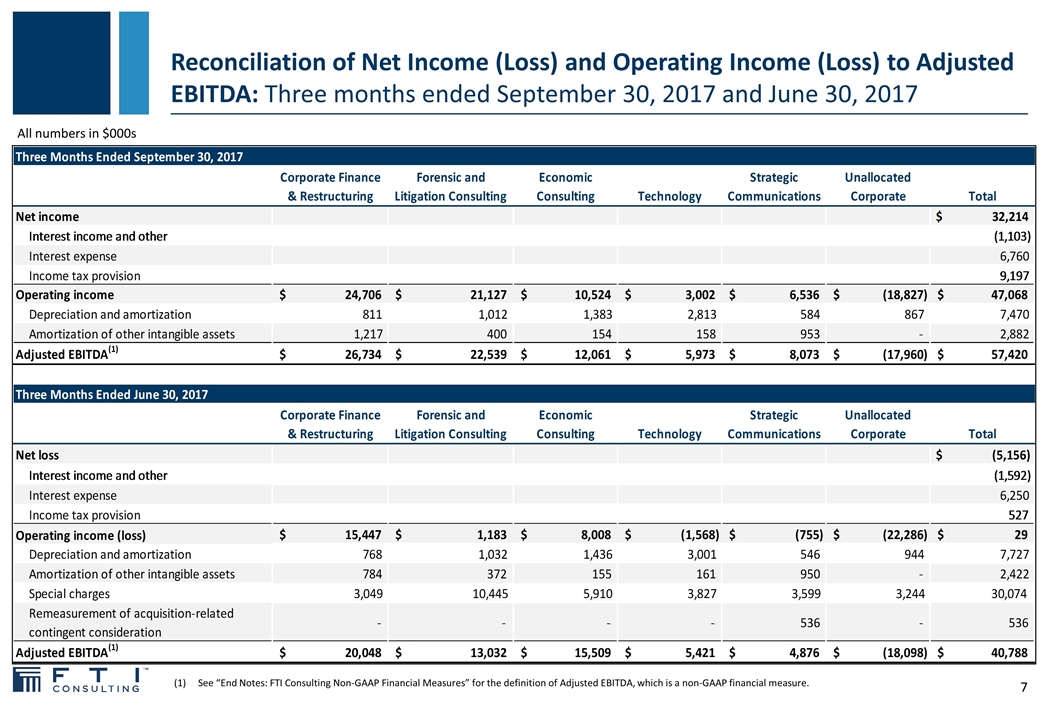
Reconciliation of Net Income (Loss) and Operating Income (Loss) to Adjusted EBITDA: Three months ended September 30, 2017 and June 30, 2017 See “End Notes: FTI Consulting Non-GAAP Financial Measures” for the definition of Adjusted EBITDA, which is a non-GAAP financial measure. All numbers in $000s
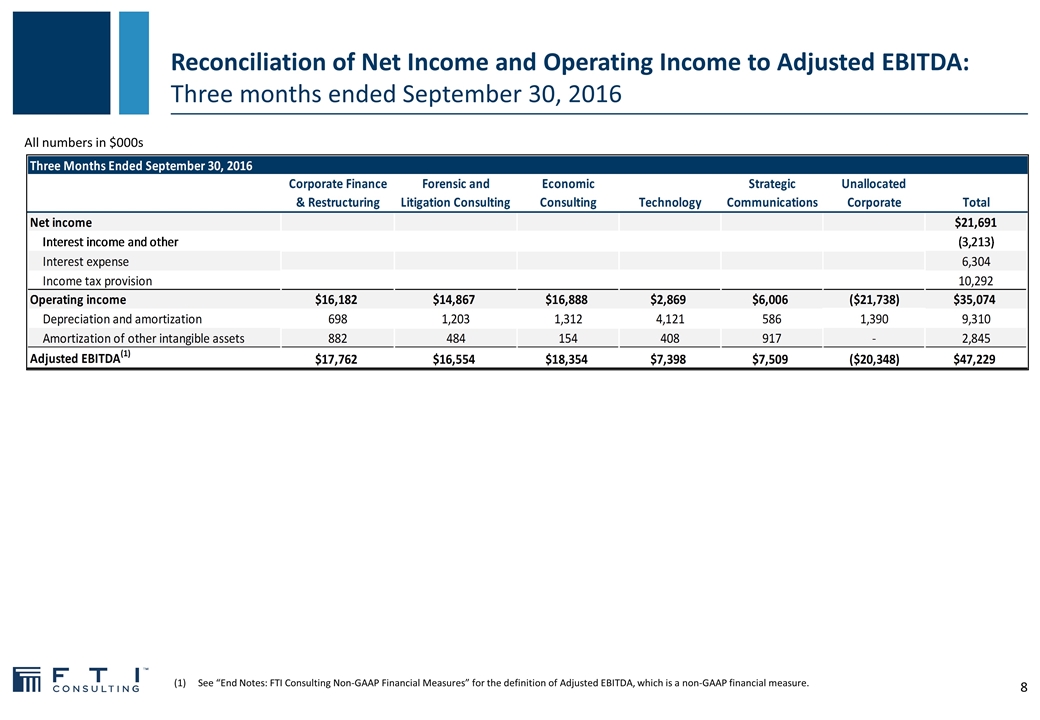
Reconciliation of Net Income and Operating Income to Adjusted EBITDA: Three months ended September 30, 2016 All numbers in $000s See “End Notes: FTI Consulting Non-GAAP Financial Measures” for the definition of Adjusted EBITDA, which is a non-GAAP financial measure.

Reconciliation of Net Cash Provided by Operating Activities to Free Cash Flow: Three months ended September 30, 2017, June 30, 2017 and September 30, 2016 All numbers in $000s See “End Notes: FTI Consulting Non-GAAP Financial Measures” for the definition of Free Cash Flow, which is a non-GAAP financial measure.

End Notes FTI Consulting Non-GAAP Financial Measures In this presentation, we sometimes use information derived from consolidated and segment financial information that may not be presented in our financial statements or prepared in accordance with GAAP. Certain of these measures are considered “non-GAAP financial measures” under the SEC rules. Specifically, we have referred to the following non-GAAP financial measures in this presentation: Total Segment Operating Income (Loss) Adjusted EBITDA Total Adjusted Segment EBITDA Adjusted EBITDA Margin Adjusted Segment EBITDA Margin Adjusted Net Income Adjusted Earnings per Diluted Share Free Cash Flow We have included the definitions of Segment Operating Income (Loss) and Adjusted Segment EBITDA below in order to more fully define the components of certain non-GAAP financial measures in this presentation. We define Segment Operating Income (Loss) as a segment’s share of Consolidated Operating Income (Loss). We define Total Segment Operating Income (Loss), which is a non-GAAP financial measure, as the total of Segment Operating Income (Loss) for all segments, which excludes unallocated corporate expenses. We use Segment Operating Income (Loss) for the purpose of calculating Adjusted Segment EBITDA. We define Adjusted Segment EBITDA as a segment’s share of Consolidated Operating Income (Loss) before depreciation, amortization of intangible assets, remeasurement of acquisition-related contingent consideration, special charges and goodwill impairment charges. We use Adjusted Segment EBITDA as a basis to internally evaluate the financial performance of our segments because we believe it reflects current core operating performance and provides an indicator of the segment’s ability to generate cash. We define Adjusted EBITDA Margin as Adjusted EBITDA as a percentage of total revenues. We define Adjusted Segment EBITDA Margin as Adjusted Segment EBITDA as a percentage of a segment’s revenues. We define Total Adjusted Segment EBITDA, which is a non-GAAP financial measure, as the total of Adjusted Segment EBITDA for all segments, which excludes unallocated corporate expenses. We define Adjusted EBITDA, which is a non-GAAP financial measure, as consolidated net income before income tax provision, other non-operating income (expense), depreciation, amortization of intangible assets, remeasurement of acquisition-related contingent consideration, special charges, goodwill impairment charges and losses on early extinguishment of debt. We believe that the non-GAAP financial measures, which exclude the effects of remeasurement of acquisition-related contingent consideration, special charges and goodwill impairment charges, when considered together with our GAAP financial results and GAAP measures, provide management and investors with a more complete understanding of our operating results, including underlying trends. In addition, EBITDA is a common alternative measure of operating performance used by many of our competitors. It is used by investors, financial analysts, rating agencies and others to value and compare the financial performance of companies in our industry. Therefore, we also believe that these measures, considered along with corresponding GAAP measures, provide management and investors with additional information for comparison of our operating results with the operating results of other companies. We define Adjusted Net Income and Adjusted Earnings per Diluted Share (“Adjusted EPS”), which are non-GAAP financial measures, as net income and earnings per diluted share, respectively, excluding the impact of remeasurement of acquisition-related contingent consideration, special charges, goodwill impairment charges and losses on early extinguishment of debt. We use Adjusted Net Income for the purpose of calculating Adjusted EPS. Management uses Adjusted EPS to assess total Company operating performance on a consistent basis. We believe that this non-GAAP financial measure, which excludes the effects of the remeasurement of acquisition-related contingent consideration, special charges, goodwill impairment charges and losses on early extinguishment of debt, when considered together with our GAAP financial results, provides management and investors with an additional understanding of our business operating results, including underlying trends. We define Free Cash Flow as net cash provided by operating activities less cash payments for purchases of property and equipment. We believe this non-GAAP financial measure, when considered together with our GAAP financial results, provides management and investors with an additional understanding of the Company’s ability to generate cash for ongoing business operations and other capital deployment. Non-GAAP financial measures are not defined in the same manner by all companies and may not be comparable with other similarly titled measures of other companies. Non-GAAP financial measures should be considered in addition to, but not as a substitute for or superior to, the information contained in our Condensed Consolidated Statements of Comprehensive Income.

Appendix
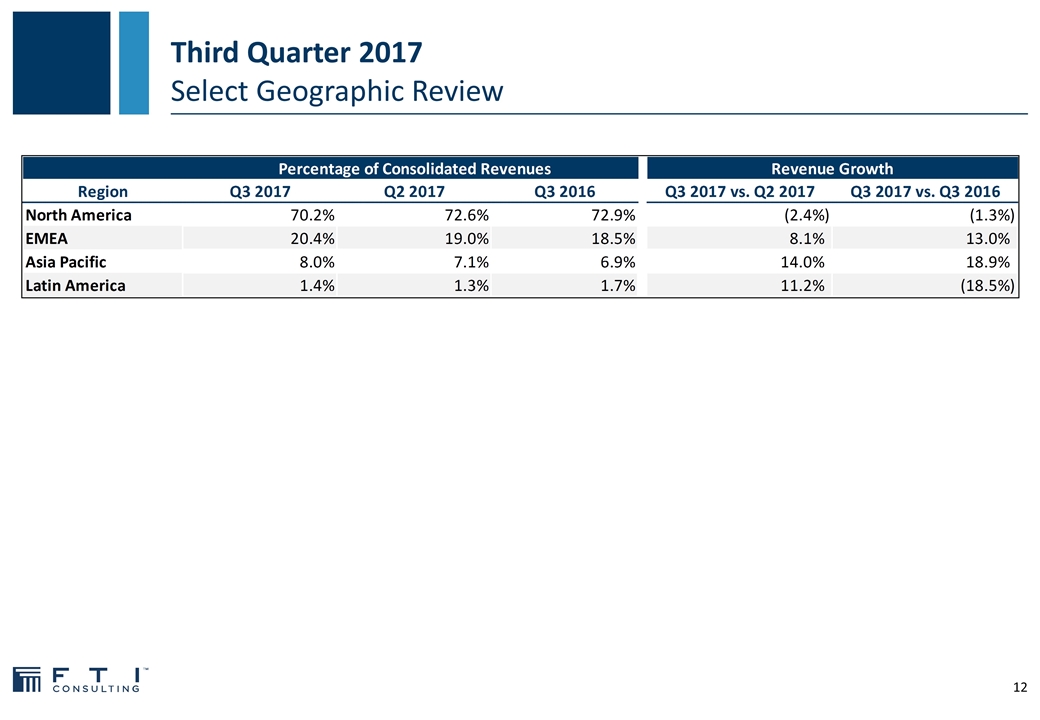
Third Quarter 2017 Select Geographic Review

